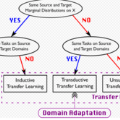Semi-supervised anomaly detection~(SSAD) is a task where normal data and a limited number of anomalous data are available for training. In practical situations, SSAD methods suffer adapting to domain shifts, since anomalous data are unlikely to be available for the target domain in the training phase. To solve this problem, we propose a domain adaptation method for SSAD where no anomalous data are available for the target domain. First, we introduce a domain-adversarial network to a variational auto-encoder-based SSAD model to obtain domain-invariant latent variables. Since the decoder cannot reconstruct the original data solely from domain-invariant latent variables, we conditioned the decoder on the domain label. To compensate for the missing anomalous data of the target domain, we introduce an importance sampling-based weighted loss function that approximates the ideal loss function. Experimental results indicate that the proposed method helps adapt SSAD models to the target domain when no anomalous data are available for the target domain.
翻译:半监督异常检测(SSAD)是一项任务,其用于训练的数据只包括正常数据和少量异常数据。在实际情况中,由于目标领域中不可能同时有异常数据,因此其方法往往难以适应领域转移。为了解决这个问题,我们提出了一种领域适应方法,用于SSAD,即在目标领域中没有异常数据的情况下。首先,我们将领域对抗网络引入基于变分自动编码器的SSAD模型,以获取领域不变的潜变量。由于解码器无法仅通过领域不变的潜变量重构原始数据,因此我们将解码器调整为以领域标签为条件因素。为了弥补目标领域缺少异常数据的缺陷,我们引入了一种基于重要性采样的加权损失函数,以近似理想的损失函数。实验结果表明,在目标领域中没有异常数据的情况下,所提出的方法有助于将SSAD模型适应于目标领域。



